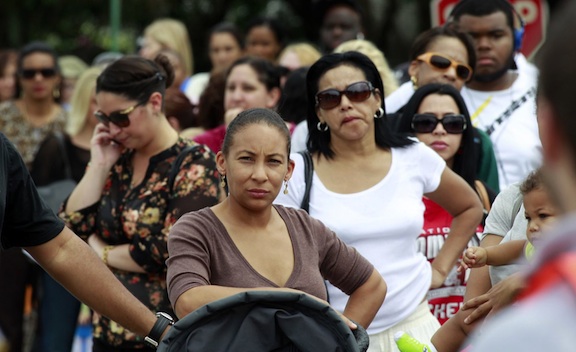Analysis: 201,000 in Florida didn't vote because of (white supremacy) long lines
(In photo white voters in Dixville Notch, New Hampshire wait to cast their votes on November 6, 2012. What is racism? [MORE]) A Jim Crow tactic. By and large, white people in white voting precincts, Democrat or Republican did not have to wait in line to vote in the Presidential election. [MORE] From [HERE] The long Election Day lines around Florida may have turned away more than 200,000 frustrated would-be voters who gave up and went home before they cast ballots — or else saw the lines and elected not to join them.
Analyzing data compiled by the Orlando Sentinel, Ohio State University professor Theodore Allen estimated last week that at least 201,000 voters likely gave up in frustration on Nov. 6, based on research Allen has been doing on voter behavior.
His preliminary conclusion was based on the Sentinel's analysis of voter patterns and precinct-closing times in Florida's 25 largest counties, home to 86 percent of the state's 11.9 million registered voters.
"My gut is telling me that the real number [of voters] deterred is likely higher," Allen said. "You make people wait longer, they are less likely to vote."
 (In photo, Non-White Voters stand in a long line at the Supervisor of Elections office in West Palm Beach, Florida for early voting on November 5, 2012.)
(In photo, Non-White Voters stand in a long line at the Supervisor of Elections office in West Palm Beach, Florida for early voting on November 5, 2012.)
Around the state, nearly 2 million registered voters live in precincts that stayed open at least 90 minutes past the scheduled 7 p.m. closing time, according to Sentinel analysis of voting data obtained from county elections supervisors. Of those, 561,000 voters live in precincts that stayed open three extra hours or longer.
And two of the five counties with the worst lines were in Central Florida. In Orange and Osceola counties, as many as 48 percent of those who cast votes on Election Day live in precincts that closed at least 90 minutes late, the analysis showed.
Elections supervisors have blamed the long lines and delays on the cutback of early-voting days from 14 to eight that was ordered by the 2011 Legislature, a record-long ballot that included 11 lengthy constitutional amendments and a 71 percent turnout for a hotly contested presidential election. Indeed, Gov. Rick Scott said last week he'd back legislation restoring the early-voting days and restricting ballot length.
But the Sentinel analysis also showed that — even in the worst-performing counties — long lines were the exception rather than the rule. In Orange and Miami-Dade, for example, more than half the precincts, including many large ones, closed before 8 p.m.
And some of the state's largest counties — notably Duval (Jacksonville) and Pinellas (St. Petersburg) — reported almost all precincts were closed by 8:30 p.m.
"As a whole and totality, with 8.5 million voters, I have to say Florida did a good election," said Florida Secretary of State Ken Detzner. "But in isolated areas, I think we find there were some management issues that could have been improved upon."
Still, according to Allen's analysis of the data, the lengthy lines lowered actual turnout by roughly 2.3 percent per hour of delay.
Said Jennifer Bitz, who said she waited more than five hours to vote at her Cape Coral precinct, "I must have seen 15 people, at least, just give up and leave off the line. I was absolutely livid. People [in line] were saying it was some sort of conspiracy."
Lee County, where she lives, ranked worst in the Sentinel analysis. Its last precinct didn't close until 2:54 a.m. Wednesday — nearly eight hours late. In all, 54 percent of the county's voters were in precincts that stayed open past 8:30 p.m — and half, or 27 percent, voted in precincts still open at 10 p.m.
"It was clear we didn't have enough scanners," said Virginia Jones, a Sanibel Democrat who spent eight hours in line and didn't vote until 11:20 p.m.
In documents provided to the state, Lee elections officials conceded its resources were inadequate, and "what we deployed on [Nov. 6] turned out not to be sufficient." Despite a 70,000 increase in registered voters since 2008, the county slashed its number of polling places from 136 to 88 and dispatched fewer ballot-scanning machines.
"The biggest surprise is that people waited so long," Allen said of his review, saying he would have expected the length of the lines to discourage even more voters. Overall, the 201,000 voters he indicated gave up equaled 2.3 percent of the Election Day turnout.
In Florida, he concluded, the lost voters appeared to favor President Barack Obama. Of the 201,000 "missing" votes, 108,000 likely would have voted for Obama and 93,000 for Republican Mitt Romney, he said.
This suggests that Obama's margin over Romney in Florida could have been roughly 15,000 votes higher than it was. Obama carried the state by 74,309 votes out of more than 8.4 million cast.
Allen's first analysis of the impact of long lines at the polls was done in 2004, when he estimated that long lines in Ohio's Franklin County, where Ohio State is located, discouraged at least 20,000 voters from casting ballots in the razor-close contest between President George W. Bush and Democrat John Kerry. He has continued his research in every election since.
